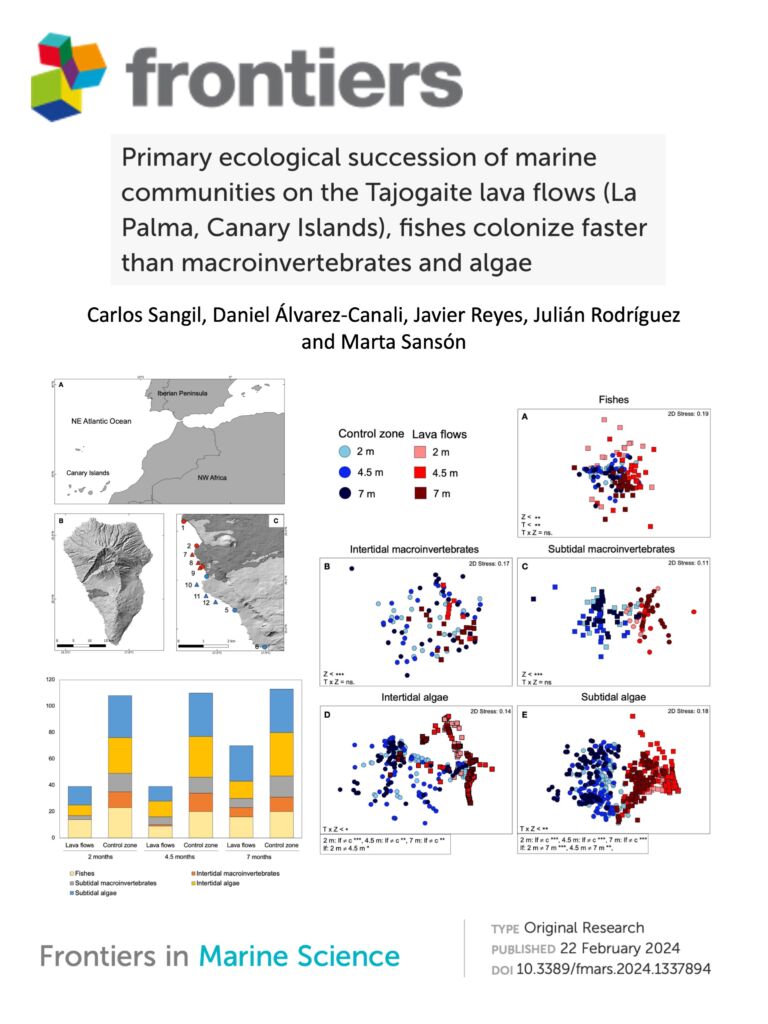Primary ecological succession of marine communities on the Tajogaite lava flows (La Palma, Canary Islands), fishes colonize faster than macroinvertebrates and algae

2024. Sangil, C., Álvarez-Canali, D., Reyes, J., Rodríguez, J., & Sansón, M. (2024). Primary ecological succession of marine communities on the Tajogaite lava flows (La Palma, Canary Islands), fishes colonize faster than macroinvertebrates and algae. Frontiers in Marine Science, 11, 1337894.
Estudiamos la sucesión primaria de las comunidades bentónicas en las coladas de lava del volcán Tajogaite a los 2, 4,5 y 7 meses tras el final de la erupción. La lava del Tajogaite generó varias coladas y arrecifes rocosos estériles que fueron monitoreados tanto en zonas intermareales como submareales hasta 20 m de profundidad. El muestreo incluyó macroinvertebrados y algas en el intermareal, y peces, macroinvertebrados y algas en el submareal. Se seleccionó una zona de control para comparar la colonización temprana de las coladas con la de un ecosistema maduro. La colonización de la lava fue rápida, con numerosas especies llegando y proliferando poco después de finalizar la erupción. Tras 7 meses, el número total de especies registradas en las coladas fue de 70, lo que representa el 64 % de las encontradas en la zona de control. Así, las comunidades se volvían progresivamente más complejas gracias a la incorporación continua de especies. El número de peces y macroinvertebrados en las coladas, tanto en el intermareal como en el submareal, aumentó progresivamente, acercándose a los valores de la zona de control. Sin embargo, las algas, en términos de cobertura total, presentaron valores similares a los de la zona de control desde el inicio del seguimiento. Todas las comunidades siguieron la misma trayectoria, convergiendo hacia comunidades semejantes a las de la zona de control, aunque la velocidad de cambio difirió con el tiempo. Después de siete meses, las diferencias en peces entre las coladas y la zona de control eran pequeñas, pero seguían siendo grandes en macroinvertebrados y algas. Así, según cada comunidad de organismos, el ecosistema bentónico de las coladas se encontraba en diferentes etapas de sucesión.
English
We studied the primary succession of benthic communities in the lava flows of the Tajogaite volcano at 2, 4.5, and 7 months after the eruption ended. The lava from the Tajogaite created several lava flows and sterile rocky reefs that were monitored in both intertidal and subtidal areas up to 20 m depth. Sampling included macroinvertebrates and algae in the intertidal, and fishes, macroinvertebrates, and algae in the subtidal. A control zone was selected to compare the early colonisation of lava flows with that of a mature ecosystem. Colonisation of the lava flow was swift, with numerous species arriving and proliferating soon after the eruption ended. After 7 months, the total number of species recorded in the lava flows was 70, representing 64% of those found in the control zone. thus, communities were gradually becoming increasingly complex owing to the continuous incorporation of species. The number of fishes, and macroinvertebrates in both the intertidal and subtidal, lava flows increased progressively, approaching the values of the control zone. However, algae, in terms of total cover, presented values similar to the control zone from the beginning of the monitoring. All the communities have followed the same trajectory to converge towards communities like those in the control zone, although the rate at which they have changed with time differs. After seven months, differences in fishes between lava flows and the control zone were small, but they were still large with respect to macroinvertebrates and algae. Thus, according to each community of organisms, the benthic ecosystem of the lava flows was found at different stages of succession.
